Symbolism, the Hiramic Legend, and the Master’s Word
|
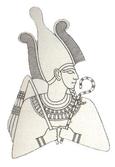
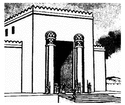
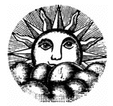
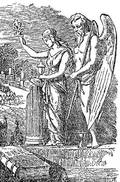
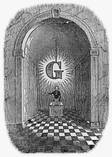

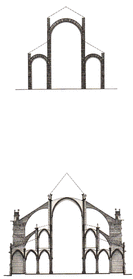
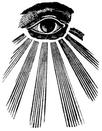
|
Legends in Antiquity
We find these characteristics in Masonry from the time of the Ancient Egyptians in the mysteries of Osiris, where it is said Moses was initiated into the solemn rites which antedated the return of the chosen people of God; in the old Persian Mysteries of Mithras, where we find traces of an unusually clear conception of a life after death; and in Syria where we find the Dionysian Mysteries which came from Greece and were probably carried by the workmen of Tyre into Jerusalem when Solomon's temple was built on Mount Moriah. We also find these four characteristics in the mysteries of Bacchus in early Rome; later in the Roman Collegia of Builders; and in the teachings of the peaceful Essenes along the Jordan, where some authorities conjecture that Jesus was initiated before the beginning of his ministry. In the middle ages we find this hieroglyphic moral system taught by types, emblems and allegories, among the Cathedral Builders; in the dark ages, we find it among the Comacine Masters on the little island in Lake Como; and we may trace it through the guilds of traveling Masons, to the Speculative Masonry of 1717, which we substantially teach today.Our Iconoclastic friends, who are interested in the history of the fraternity, may smile at the dream of a symbolist, but bear in mind that we are not speaking of the fraternity when we use the word Masonry; we are speaking of that hieroglyphic, moral system taught agreeably to ancient customs by types, emblems and allegorical figures; and having four principal ideas: a belief in one God, a life after death, a symbolical idea of building, and the seeking after something which was lost. It is true that the careful student finds clouds of darkness occasionally hiding these real intents and purposes. At times we read of the ceremonies degenerating into the common and vulgar, as in the case of the mysteries of Bacchus at Rome. But like the hidden river which disappears under ground, only to flow out fresh and pure farther on; so we find these fundamental characteristics of Masonry occasionally hidden, but later coming to light. Considerable has been written on all of these four characteristics, especially on the belief in one God and on the idea of building. Let us also look into the subjects of immortality and the seeking after something which was lost. These two subjects are so closely akin to the legends of Hiram and of the Master's Word in our Masonry of today, that it may be well for us to see what meaning these two symbols had in the Masonry of Antiquity. In the ancient Egyptian Mysteries, Osiris represented the spirit of the Sun, the principle of light and life. He was assailed by the powers of evil and was killed, and apparently the forces of darkness ruled. Isis went out to seek for him, and Osiris was later resurrected and brought to life. This story was portrayed in dramatic form in the Egyptian mysteries. The facts are verified by Plutarch, Plato, Epictetus, and others. Substantially the same story was told by Mithras in the old Persian Mysteries, of Dionysus in the Grecian and Syrian Mysteries, and of Bacchus in the early Roman rites. All were slain and then sought for, and finally raised or brought to life. A death and a life after death has been one of the fundamental teachings of Masonry in all ages. These old mysterious ceremonies have been an expression of that idea of immortality which seems to be ever present in the heart of man from remotest antiquity. The ancient sun-worshipers saw the sun retire in the Fall and reach the Winter solstice. If, as some antiquarians think, the sun worship had its beginning in the far north, the old Norseman on the shores of the Arctic seas experienced a long period of night during the Winter. In the Spring, they saw the sun's resplendent rays again light and warm the earth. The old legend was that the sun was slain and that during the period of darkness, the sun was dead; and that later the sun, as in the case of Osiris, Mithras, and Dionysus, was brought to life again and there was light and life. Ceremonies were instituted and the lesson of a life after death, was taught by a dramatic portrayal very similar in character to that of the legend of Hiram today. The Legend of Hiram In the legend of Hiram we may find the lesson of immortality, and we may also find one of the greatest tragedies ever conceived by man. Edwin Booth, the famous Shakespearian actor, referred to the legend of Hiram as the most sublime tragedy; and said that in its portrayal in a Masonic lodge, he would rather play that part without applause, than to play the greatest tragedy Shakespeare ever wrote. We may find in the journey of Hiram the symbol of Man's journey through life. In this journey, man encounters many obstacles which may be symbolically referred to as enemies. They may be considered as accosting him from the three aspects of his being--the mental, spiritual and physical. Three of these enemies are Ignorance, Doubt, and Prejudice. The encounter with Ignorance may be considered as symbolical of the first effort made by man in his progress. Perhaps the twenty-four inch gauge, as the weapon used by ignorance, is symbolical of the mental and the idea that the knowledge which man already has, is sufficient. As he presses on in his journey for further light, Doubt is encountered. The little knowledge which man has, may be confined to material things, and there is doubt about those things which are not material. Perhaps the square, symbolical of the earth, may be used by Doubt and a correct understanding of great eternal and spiritual truths prevented by confusion with earthly things. If man still presses onward, he may encounter a third and more deadly enemy--Prejudice--which often slays him and stops his progress. The word prejudice comes from the Latin, Prae meaning before, and Judicium meaning judgment. Prejudice is a previous judgment, clung to even after contrary facts are disclosed. Our prejudices, or previous judgments, often come from the passions. Fear, hatred, jealousy, and love of the passionate sort, all engender prejudice. These passions have their abiding place in the physical. The Master’s Word In addition to the universally taught lesson of immortality, we find in the lodge a continued admonition to seek for the Master's Word. But even after we have completed the several degrees, we do not find the Master's Word. In the last degree of the Blue Lodge, we find that as Master Masons, we will have to be content with a substitute. All through the degrees of the Ancient and Accepted Scottish Rite, we find further indications of this continued seeking. At last, when a brother is made Sublime Prince of The Royal Secret, he still receives an admonition to advance, to progress, and to seek. "He is to advance and conquer in his heart those old enemies, Ignorance, Doubt, and Prejudice, and to seek the Master's Word." That is the Royal Secret. In the degree of the Royal Arch, we are told that in a book there is a key to the Master's Word. The Master's Word is not a few meaningless syllables whispered in the ear, neither is it a few arbitrary characters. Neither is it the name of the Great Jehovah, unless it is considered in a symbolical sense, as representing Truth and Perfection. The key to the Master's Word is in the book, which to us is the Holy Bible, the Great Light in Masonry. There, we will find the key to the Master's Word, but not the Master's Word itself. Finding That Which Was Lost What is this Master's Word, and why this continual search? We find in the Masonic funeral service an allusion to a certain "pass" whereby we may obtain entrance into the Grand Lodge above. What higher conception could we have of the Master's Word, than the pass whereby we can find immortality and entrance into the Grand Lodge on High? We are told that this pass is, "the pass of a pure and blameless life." The symbolism is perfect. Now we know why we will have to be content with a substitute, because on earth we will not attain the Master's Word, "the pure and blameless life." We learn that Moses had this Master's Word; his inspiration came direct from God himself. Solomon had the Master's Word, until he did that which was evil in the sight of the Lord, then he lost the Master's Word. It was buried amid the rubbish of his physical temple. But since we cannot attain this Master's Word, "the pure and blameless life," why are we so continually admonished to seek for it ? Why seek for that which we cannot find ? Why this ceaseless, endless search for perfection and truth, only to receive a substitute ? Because in the very seeking for the Master's Word, "a pure and blameless life," we come nearer to it. Like the Cathedral Spires of Gothic Architecture, which point upward, although they never reach heaven; we find that in our seeking after perfection, we come nearer and nearer to it. The Real Purpose of Masonry The seeking for the Master's Word, therefore, is the real purpose of Masonry--that hieroglyphic moral system of types, emblems and allegories. It should be the purpose and the object of every true and worthy brother to find this Master's Word. With the thought of the unity of God, the hope of immortality, and the seeking after the perfect life, we will build a temple that will be eternal. We will also exercise that charity toward the weaknesses and failings of others, which is incumbent on all Masons; and as taught in the Council Degrees of Royal and Select Masters, we will deposit in the secret vault true copies or counterparts of those sacred treasures of Mercy, Justice, and Love, which are in the Sanctum Sanctorum above. Then, after the destruction of this temple, the treasures or their counterparts will be found at the building of a second temple not made with hands but eternal in the heavens, and there we will find the true Master's Word, "the pure and blameless life"--not here, but hereafter. Back to previous page Acknowledgement: This article was originally, a lecture by J. Otis Ball which appeared in the Builder Magazine, Volume I, Number 12, December 1915 and posted in the website of phoenixmasonry.org. Accessed 12/15/2007
|